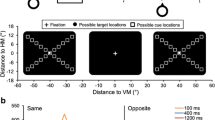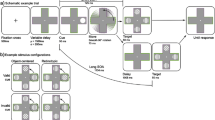Abstract
Visual attention can be oriented toward a spatial location in the visual field exogenously by an abrupt onset of a peripheral cue. In a series of behavioral studies on exogenous orienting of attention with a double-cue paradigm, we demonstrated a functional subdivision of perceptual space in the visual field. Specifically, inhibition of return (IOR) is much stronger at periphery relative to perifoveal visual field up to approximately 15° eccentricity, suggesting two dissociable functional areas in the visual field. To further investigate the generality of this functional subdivision of the visual field, we measured IOR effects with another single-cue paradigm and applied a very short cue-target interval that was typically anticipated not to observe any inhibitory effect at all. Consistent with this expectation, no IOR effects at the eccentricities up to 15° were observed. However, significant IOR effects beyond 15° eccentricities were consistently demonstrated. These results not only revealed an early onset of IOR for more peripheral stimuli, but also confirmed that the perceptual space in the visual field is not homogeneous but underlies a functional subdivision with a border of ca. 15° eccentricity.


Similar content being viewed by others
References
Bao Y, Pöppel E (2007) Two spatially separated attention systems in the visual field: evidence from inhibition of return. Cogn Process 8:37–44
Bao Y, Zhou J, Fu L (2004) Aging and the time course of inhibition of return in a static environment. Acta Neurobiol Exp 64:403–414
Bao Y, Sander T, Trahms L, Pöppel E, Lei Q, Zhou B (2011) The eccentricity effect of inhibition of return is resistant to practice. Neurosci Lett 500:47–51
Bennett PJ, Pratt J (2001) The spatial distribution of inhibition of return. Psychol Sci 12:76–80
Berlucchi G (2006) Inhibition of return: a phenomenon in search of a mechanism and a better name. Cogn Neuropsychol 23:1065–1074
Berlucchi G, Tassinari G, Marzi CA, Di Stefano M (1989) Spatial distribution of the inhibitory effect of peripheral non-informative cues on simple reaction time to non-fixated visual targets. Neuropsychologia 27:201–221
Frost D, Pöppel E (1976) Different programming modes of human saccadic eye movements as a function of stimulus eccentricity: indications of a functional subdivision of the visual field. Biol Cybern 23:39–48
Kingstone A, Pratt J (1999) Inhibition of return is composed of attentional and oculomotor processes. Percept Psychophys 61:1046–1054
Lei Q, Bao Y (2012) The eccentricity effect of inhibition of return is independent of cortical magnification. J Vis (in press)
Popovic Z, Sjöstrand J (2001) Resolution, separation of retinal ganglion cells, and cortical magnification in humans. Vision Res 41:1313–1319
Pöppel E, Harvey LO Jr (1973) Light-difference threshold and subjective brightness in the periphery of the visual field. Psychol Forsch 34:145–161
Pöppel E, von Cramon D, Backmund H (1975) Eccentricity specific dissociation of visual functions in patients with lesions of the central visual pathways. Nature 256:489–490
Posner MI, Cohen Y (1984) Components of visual orienting. In: Bouma H, Bouwhuis DG (eds) Attention and performance X. Erlbaum, Hillsdale, pp 531–556
Sapir A, Soroker N, Berger A, Henik A (1999) Inhibition of return in spatial attention: direct evidence for collicular generation. Nat Neurosci 2:1053–1054
Stoerig P, Pöppel E (1986) Eccentricity-dependent residual target-detection in visual field defects. Exp Brain Res 64:469–475
Tassinari G, Aglioti S, Chelazzi L, Marzi CA, Berlucchi G (1987) Distribution in the visual field of the costs of voluntarily allocated attention and of the inhibitory after-effects of covert orienting. Neuropsychologia 25:55–71
Acknowledgments
This research was supported by grants from the national Natural Science Foundation of China (No. 30670703 and No. 91120004).
Conflict of interest
This supplement was not sponsored by outside commercial interests. It was funded entirely by ECONA, Via dei Marsi, 78, 00185 Roma, Italy.
Author information
Authors and Affiliations
Corresponding author
Rights and permissions
About this article
Cite this article
Bao, Y., Wang, Y. & Pöppel, E. Spatial orienting in the visual field: a unified perceptual space?. Cogn Process 13 (Suppl 1), 93–96 (2012). https://doi.org/10.1007/s10339-012-0469-5
Published:
Issue Date:
DOI: https://doi.org/10.1007/s10339-012-0469-5




